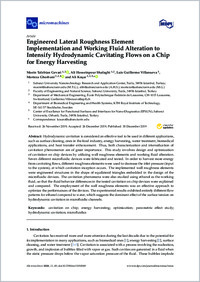Engineered Lateral Roughness Element Implementation and Working Fluid Alteration to Intensify Hydrodynamic Cavitating Flows on a Chip for Energy Harvesting.
- Gevari MT Sabanci University Nanotechnology Research and Application Center, 34956 Tuzla, Istanbul, Turkey.
- Shafaghi AH Sabanci University Nanotechnology Research and Application Center, 34956 Tuzla, Istanbul, Turkey.
- Villanueva LG Department of Mechanical Engineering, École Polytechnique Fedérale de Lausanne, Lausanne CH-1015, Switzerland.
- Ghorbani M Sabanci University Nanotechnology Research and Application Center, 34956 Tuzla, Istanbul, Turkey.
- Koşar A Sabanci University Nanotechnology Research and Application Center, 34956 Tuzla, Istanbul, Turkey.
- 2020-01-08
Published in:
- Micromachines. - 2019
cavitation on chip
energy harvesting
hydrodynamic cavitation
microfluidics
optimization
parametric effect study
English
Hydrodynamic cavitation is considered an effective tool to be used in different applications, such as surface cleaning, ones in the food industry, energy harvesting, water treatment, biomedical applications, and heat transfer enhancement. Thus, both characterization and intensification of cavitation phenomenon are of great importance. This study involves design and optimization of cavitation on chip devices by utilizing wall roughness elements and working fluid alteration. Seven different microfluidic devices were fabricated and tested. In order to harvest more energy from cavitating flows, different roughness elements were used to decrease the inlet pressure (input to the system), at which cavitation inception occurs. The implemented wall roughness elements were engineered structures in the shape of equilateral triangles embedded in the design of the microfluidic devices. The cavitation phenomena were also studied using ethanol as the working fluid, so that the fluid behavior differences in the tested cavitation on chip devices were explained and compared. The employment of the wall roughness elements was an effective approach to optimize the performances of the devices. The experimental results exhibited entirely different flow patterns for ethanol compared to water, which suggests the dominant effect of the surface tension on hydrodynamic cavitation in microfluidic channels.
- Language
-
- English
- Open access status
- gold
- Identifiers
-
- DOI 10.3390/mi11010049
- PMID 31906037
- Persistent URL
- https://sonar.rero.ch/global/documents/190594
Statistics
Document views: 27
File downloads:
- fulltext.pdf: 0
